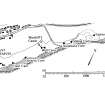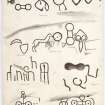East Wemyss, Jonathan's Cave
Cave (Period Unassigned), Pictish Symbol Rock Carving(S) (Pictish)
Site Name East Wemyss, Jonathan's Cave
Classification Cave (Period Unassigned), Pictish Symbol Rock Carving(S) (Pictish)
Alternative Name(s) Wemyss Caves; Factor's Cave
Canmore ID 53979
Site Number NT39NW 9
NGR NT 3456 9723
Datum OSGB36 - NGR
Permalink http://canmore.org.uk/site/53979
- Council Fife
- Parish Wemyss
- Former Region Fife
- Former District Kirkcaldy
- Former County Fife
East Wemyss, Jonathan’s Cave, Fife, Pictish rock carvings
Measurements:
Stone type: sandstone
Place of discovery: NT 3456 9723
Present location: in situ.
Evidence for discovery: Simpson and others visited the caves in 1865.
Present condition: weathered.
Description
On the walls are carved double-disc symbols, Pictish beasts, birds, animals and fish, together with a boat with high prow and stern, rudder and five oars.
Date range: sixth to eighth century.
References: Simpson 1866; Ritchie & Stevenson 1993; Fraser 2008, no 81.3.
Compiled by A Ritchie 2016
Reference (1903)
Jonathan's Cave.- The fish symbol.
The bird symbol (repeated five times).
The elephant symbol (repeated twice).
The double-disc symbol without the Z-shaped rod (repeated four times).
The rectangular symbol.
The two-legged rectangular symbol (repeated twice).
A lion (?).
A man driving a beast.
Two men.
A shield-shaped figure.
A fleur de lys.
A swastika cross.
Five small crosses.
A trident.
Two crosses (?) like a pricket candlestick.
A trident and two small circles.
J R Allen and J Anderson 1903
Publication Account (1933)
Sculptures in Caves, Wemyss.
On the shore in the neighbourhood of East Wemyss are five caves, the walls of which are marked with a great number of devices, some similar to those found on sculptured slabs. The caves and their markings are fully described and illustrated with drawings in Proceedings of the Royal Society of Edinburgh, v (1866), p. 521, &c.; Proc. Soc. Ant. Scot., xi (1874-6), pp. 107-20; Early Christian Monuments of Scotland, pp. 370-3.
RCAHMS 1933.
Field Visit (6 October 1954)
A large cave extending some distance until blocked by fallen stone. Sculptures as described above could be traced on both sides of the cavern.
Visited by OS (J F C) 6 October 1954.
Excavation (1980 - 1985)
Excavation 1980 and 1985 in advance of coastal erosion. Radiocarbon dates 280 +/- 50 bc (GU-2138) layer 5; first midden material. 995 +/- 70 ad (GU-1369) layer 2; beneath massive paving.
E W MacKie 1986.
Field Visit (1996)
Site recorded by Maritime Fife during the Coastal Assessment Survey for Historic Scotland, Kincardine to Fife Ness 1996
Laser Scanning (1 November 2013 - 24 April 2014)
NT 34563 97237 A programme of digital documentation was carried out, 1 November 2013 – 24 April 2014, of Jonathan’s Cave and the early medieval (Pictish) carvings within it, by The SCAPE Trust, the Save the Ancient Wemyss Caves Society (SWACS) and the York Archaeological Trust.
The Wemyss Caves and the unique carvings they contain are under immediate and future threat from structural decay, coastal erosion and vandalism. The work aimed to create a digital record of the caves and carvings, as a means of preservation by record and to create an online interpretive resource to bring the Wemyss Caves to the attention of a
global audience. Laser scanning, photogrammetry, structured light scanning and Reflectance Transformation Imaging (RTI) techniques were used to re-create an interactive 3D digital record of Jonathan’s Cave and carvings. A reminiscence dropin weekend recorded local memories, stories and memorabilia about the Wemyss Caves. The website allows the user to explore the cave, access historic information and examine the
carvings with a virtual torch.
Archive: ADS (intended). Website: http://www.4dwemysscaves.org/
Funder: Heritage Lottery Fund, Historic Scotland and Fife Council
Joanna Hambly – The SCAPE Trust
(Source: DES)
Note (May 2017)
On the walls of the cave, only the shadows are the truth
The caves at East Wemyss in Fife contain a large number of carved symbols, mainly Pictish but also Christian and Viking, which have fascinated antiquarians and researchers ever since they were first recorded in 1865. Of the six caves known to contain carvings, only four feature the Pictish carvings for which the site is famous: these are known as Court Cave, Jonathan’s Cave, Sliding Caves and West Doo Cave.
We are used to seeing Pictish carvings as prominent and accomplished public works of art: think of the detailed symmetry and storytelling found on cross slabs or the flowing, linear depictions of people, animals and symbols carved into stones standing proud in the landscapes of northern Scotland. The Wemyss Caves carvings are very different. Hidden in the dark recesses of the caves, they are a collection of symbols and figures that vary in skill and style from the accomplished to the “rough and ready”. The impression is of multiple individuals coming to the caves to make their mark but their identity and reasons remain a mystery. The only similar site that we know of is Sculptor’s Cave, Covesea but the layout and use of that site is very different: Wemyss has many more symbols, but none of the ritual remains found at Covesea.
Symbols from other eras can also be found, ranging from early Christian crosses to early modern graffiti. Two of these carvings are particularly enigmatic; a small human figure holding a rod, sword or club, and a boat with high prows, a row of five oars and a large tiller. These are cut in a different style to the Pictish carvings and may date from the period when Vikings roamed the Firth of Forth.
The earliest photographs of the carvings were likely taken in 1902 by the photographer John Patrick. Born in Buckhaven, Fife in 1831 John Patrick first became a baker and then moved to Leven where he opened a business as a bookseller, before becoming interested in photography. He opened his first studio in Leven at the age of 22 and later had premises in Kirkcaldy and Wemyssfield. In 1884 he opened an Edinburgh studio. He was a member of the Edinburgh Photographic Society and contributed to several exhibitions, specialising in landscape and portrait photography. He was a writer and a painter, and was very interested in archaeology and history, documenting and photographing sites in Fife like the standing stones at Lundin Links and a cist found at Denbeath.
In 1902 John Patrick took a series of photographs of the symbols and caves at East Wemyss, and prepared articles for publication in The Reliquary and Illustrated Archaeologist in 1905 and 1906 where he discussed the meanings of the symbols, hoping his photographs and research would provide a detailed record and to ‘cause something to be done for the protection from injury of so remarkable a series of early sculptures’. In a later account his daughter, Jessie Patrick Findlay, who often accompanied her father to the caves describes his interest: ‘My father had made the study of the Caves of Wemyss emphatically his own. He was a native of the district’.
Photographing the carvings was difficult, there was no natural light and he had to use a magnesium wire or ribbon to provide the necessary light for a long-exposure photograph on to a glass plate negative. His photographs are now an invaluable record of the carvings and caves, especially since some are no longer accessible or damaged. John Patrick retired as a professional photographer in 1912 and died in Kennoway 1923.
All things are subject to decay and change
John Patrick’s plea for ‘something to be done for the protection from injury’ of the site is even more timely today. The caves face multiple threats from coastal erosion, rising sea levels, vandalism and the soft and fragmentary nature of the rock itself which is vulnerable to erosion, delamination and collapse at both the small and the large scale. Over the past century or so, almost all the caves have experienced significant rockfalls or landslips. As a result, West Doo Cave and Glass Cave have been substantially filled in and carvings have been lost in Jonathan’s Cave.
These ongoing and unpredictable processes are a threat to the caves and their carvings but are also a threat to visitors. The caves and the area around them cannot and should not be considered safe to enter. Anyone considering entering the caves should make themselves aware of the potential risks and assess the situation on the ground.
The Save Wemyss Ancient Caves Society (SWACS) leads tours to view the carvings in the summer, if conditions permit. Details can be found on their websites via the link below. With the help of a number of national and local bodies including Historic Environment Scotland, Fife Council, the SCAPE Trust, the Wemyss Estates (the owners of the sites) and the Heritage Lottery Fund, SWACS have also developed the first ever management plan for the site which lays out a scheme of action to record and protect the caves and their carvings.
Acknowledging the important foundations that John Patrick and others have left us, this management plan has driven a major digital recording project for the caves and their and the results can be seen on the Wemyss 4D website. Now anyone can explore the caves at the click of a mouse using the legacy provided by Wemyss 4D.
The HES archive hold a collection of original prints by John Patrick as well as glass negatives illustrating the caves, along with other material including drawings and rubbings from 1866 in the Society of Antiquaries of Scotland Collection as well as modern survey material available on Canmore and for consultation in our Search Room.
Deirdre Cameron – Senior Casework Officer and Kristina Watson - Archivist
Desk Based Assessment
NT39NW 9 3456 9723
NT 3456 9723) Jonathan's Cave (NR)
OS 25" map, (1961)
There are many Celtic symbols carved on the walls of Jonathan's Cave.
Information from OS.
J R Allen and J Anderson 1903; RCAHMS 1933.
External Reference
Casts of some of the carvings are in the National Museum of Antiquities of Scotland (NMAS accession nos. IB 268-277).
Information from NMAS accession list.
Note
For geomorphological survey of adjacent coastline and trial excavation of midden, see NT39NW 31.














































































































































